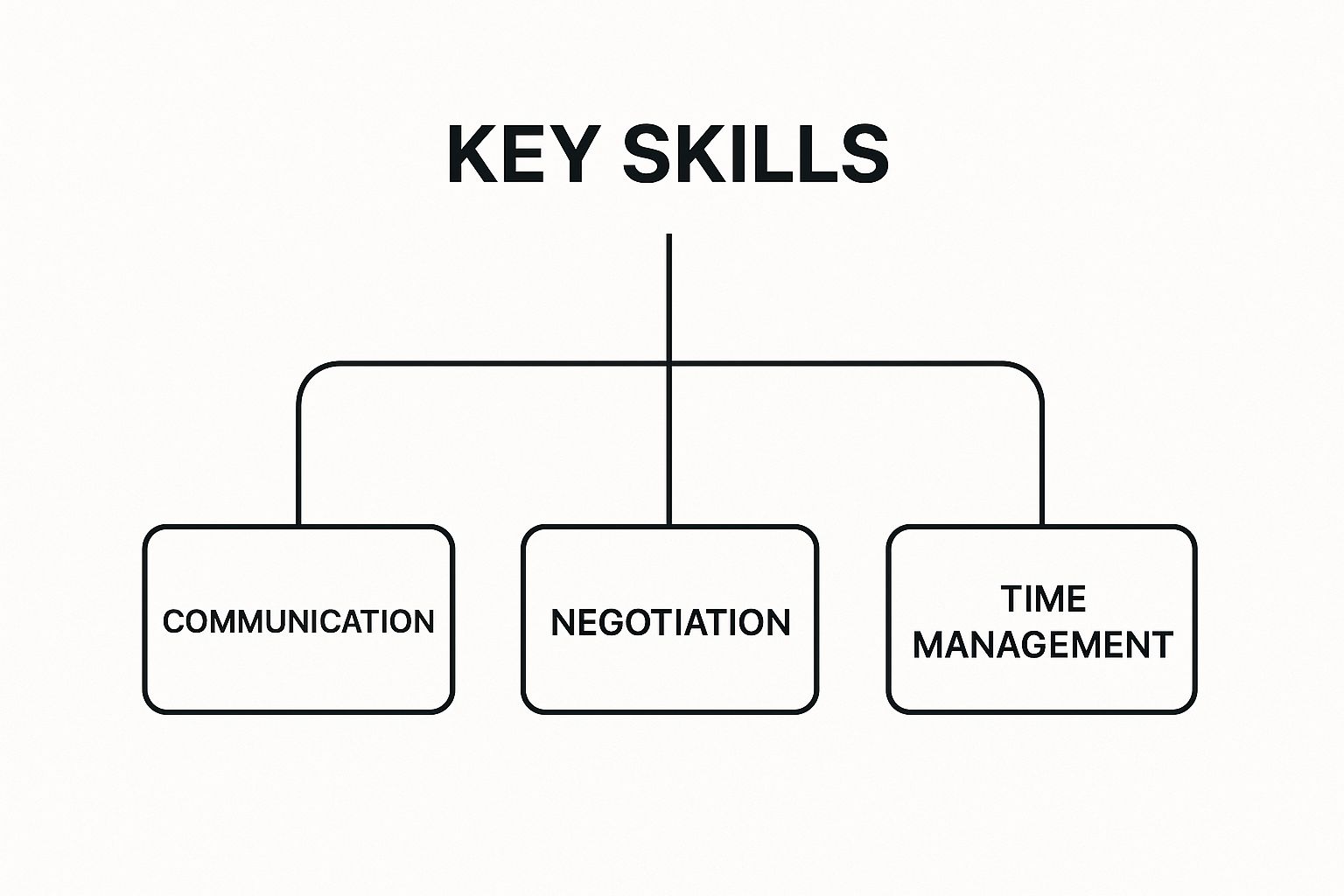What Outside Sales Representatives Actually Do Every Day

Picture this: while your inside sales colleagues are brewing their morning coffee, you’re already on the road as an outside sales representative, heading to your first client meeting. Your office? It changes daily. One day it’s a busy construction site, the next a quiet residential neighborhood. This constant change of scenery is at the heart of outside sales.
Outside sales reps aren’t tethered to a desk. They're out in the field, building genuine connections and tackling customer challenges head-on.
A typical day might begin with reviewing your territory strategy and prioritizing key accounts. This planning stage is like setting the foundation for a well-built house – crucial for a productive day. Next, it’s off to client meetings. But you’re not just showcasing products; you’re becoming a trusted advisor.
This means truly listening to your clients, understanding their pain points, and adapting your approach to their specific needs. It’s about building rapport and demonstrating how your product or service is the answer they've been searching for.
Outside sales reps also dedicate time to prospecting for new leads. This could involve attending industry events, networking in their local community, or utilizing tools like LeadFlow Manager to identify potential customers. For reps specializing in door-to-door sales, check out our helpful resources for door-to-door sales teams. Mastering the balance between prospecting and nurturing existing clients is a vital skill in outside sales.
Finally, the workday often concludes with follow-up communication. This includes sending proposals, addressing client inquiries, and scheduling the next steps. This commitment to staying connected strengthens client relationships and ultimately drives sales.
In California, outside sales roles often have unique compensation structures. Due to specific state regulations, outside sales representatives may be exempt from minimum wage and overtime rules, with their income largely based on commissions. Learn more about these California sales regulations here: https://employers.org/2024/03/01/is-my-salesperson-exempt-from-wage-and-hour-requirements/. This commission-based model can result in annual earnings between 100,000 and 175,000 for positions like the outside sales representative at One Day Doors & Closets in Santa Clara, highlighting the significant earning potential in this field.
Skills That Separate Elite Performers From The Pack

This infographic gives you a quick snapshot of the core skills every successful outside sales rep needs. It highlights communication, negotiation, and time management – the foundation for building relationships, closing deals, and effectively covering your territory. Think of these skills as the essential building blocks for everything else.
The Power of Emotional Intelligence
Product knowledge is essential, sure. But emotional intelligence (EQ) is often the secret sauce that separates good reps from truly great ones. Imagine knowing everything about your product but failing to connect with the person sitting across from you. Building trust is key, especially in places like California where personal connections are highly valued. EQ helps you truly understand your prospect's needs, anticipate their concerns, and tailor your approach accordingly.
To understand its purpose, let's consider this table:
table block not supported
This table illustrates how these skills directly impact sales performance. The differences between elite and average performers become clear, showing why these specific competencies are so crucial.
Mastering the Art of Consultative Questioning
The best outside sales reps don’t just pitch – they ask questions. They know that real selling is about uncovering a prospect’s pain points and presenting their product as the solution. This consultative approach turns a sales pitch into a genuine conversation. Instead of pushing features, they draw out the prospect's needs, becoming a trusted advisor, not just another vendor.
Strategic Territory Management
Top performers treat their territory like their own business. They create strategic territory management plans, focusing on high-value prospects and planning efficient travel routes. They know time is money, literally. Effective territory management ensures they’re talking to the right people at the right time. Want to dive deeper into efficient lead management? Check out this article on best practices for lead routing: Lead Routing Best Practices to Boost Sales Efficiency.
Adaptability and Resilience
Finally, successful outside sales reps are adaptable and resilient. They know every day will bring curveballs. Cancelled meetings, grumpy prospects, traffic jams – it all happens. The ability to roll with the punches and stay positive is crucial for long-term success. Resilience is the fuel that keeps top performers going, even when things get tough.
The Real Story Behind Outside Sales Compensation

Let's be frank: the appeal of outside sales often boils down to earning potential. But the reality of how outside sales reps get paid is more nuanced than those glossy brochures might suggest. It's not just a salary; it's a carefully balanced combination of factors.
Decoding the Compensation Structure
Think of a typical outside sales compensation package like a three-legged stool: base salary, commissions, and bonuses. Each leg is essential for stability. The base salary provides a predictable income stream, while commissions and bonuses offer the chance to earn significantly more based on performance.
Imagine a software sales rep with a 60,000 annual base salary and a 10% commission on every deal closed. Closing a 100,000 deal adds $10,000 to their earnings. Many companies also offer bonuses for exceeding targets, achieving key performance indicators (KPIs), or landing big accounts.
The Impact of Location and Experience
Where you work matters. Cost of living, market demand, and the concentration of specific industries in certain areas all affect salaries. Experience also plays a big role. Entry-level reps naturally earn less than seasoned pros with proven track records.
For example, the average salary for an outside sales rep in California in 2025 is reportedly around 49,132**, according to [PayScale](https://www.payscale.com/research/US/Job=Outside_Sales_Representative/Salary/f20925a5/California-CA). However, Indeed shows an average closer to **82,830 per year, plus an average commission of $22,560 annually. This difference highlights how location and specific job details can lead to significant variations in compensation even within the same state.
Hidden Costs to Consider
Beyond the salary figures, think about the hidden costs. Outside sales often involves a lot of travel. Expenses like gas, car maintenance, and even client meals can impact your actual take-home pay. Some companies offer reimbursement, but understanding these details is crucial when evaluating a compensation package.
Strategies for Maximizing Earnings
To succeed in this compensation landscape, know your worth and don't be afraid to advocate for yourself. Track your performance, consistently demonstrate success, and stay up-to-date on industry benchmarks. This knowledge empowers you to negotiate effectively and maximize your earnings, especially in commission-based roles.
Mastering Territory Management Like A Business Owner
The best outside sales reps don't just work their territories; they own them. They think strategically, like a business owner, carefully planning and optimizing every action. They see their territory not as a static list of accounts, but as a living, breathing market. This means constantly analyzing the landscape and adapting their strategies to succeed.
Analyzing Your Market Like A Consultant
Imagine you're a consultant brought in to help a business thrive. Where would you start? You'd analyze the market, identify the key players, and understand the competitive dynamics. Outside sales reps should do the same. They need to identify the highest-value prospects within their territory and understand their specific needs. This goes beyond simple demographics. It means digging deep to uncover the challenges and opportunities facing each business.
Creating Systematic Coverage Plans
Effective territory management isn't about winging it. It's not about randomly visiting clients whenever you have free time. Instead, think of a general meticulously planning a campaign, strategically positioning troops for maximum impact. Outside sales reps need to develop similarly systematic coverage plans to maximize both their efficiency and their results. This means geographic optimization, prioritizing accounts not just on their potential but also on their proximity to each other. This minimizes travel time and maximizes valuable face-time with qualified prospects. Tools like LeadFlow Manager can be incredibly helpful for reps in CA, allowing them to organize and optimize their field activities for maximum impact. You might also be interested in our guide on LeadFlow Manager's Use Cases for Field Sales Teams.
Balancing Existing Customers and New Relationships
Just like a business owner balances serving current clients with attracting new ones, so too must an outside sales rep. Nurturing existing relationships is crucial, but so is the long-term growth that comes from developing new ones. This requires careful prioritization and effective time management. It's about knowing which accounts offer immediate revenue opportunities and which hold the promise of future growth. Ultimately, it’s about making smart decisions that maximize both short-term gains and long-term sustainability.
Tracking Performance and Identifying Key Activities
Successful business owners constantly monitor performance metrics. They need to know what’s working and what isn’t. The same is true for outside sales reps. Performance tracking is essential, and it goes far beyond simply logging activities. It’s about understanding which activities actually drive revenue and which are just keeping you busy. This data-driven approach allows you to identify areas for improvement, optimize your strategies, and demonstrate your value to management.
To further illustrate different approaches to territory management, let's examine a few strategic frameworks. The following table outlines various strategies, their implementation timelines, resource requirements, and expected returns.
Territory Management Strategy Framework A comprehensive comparison of different territory management approaches, showing implementation requirements, resource needs, and expected returns for various strategic methods
table block not supported
This table highlights the trade-offs between different territory management strategies. High-touch approaches require significant investment but offer substantial returns, while rapid expansion strategies require less upfront investment but may yield less predictable long-term growth. Choosing the right strategy depends on your specific territory characteristics and overall business goals.
Technology Stack That Actually Moves The Needle

Remember the days of overflowing Rolodexes and briefcases stuffed with brochures? Those are long gone. Today's outside sales landscape demands a smart technology stack to truly succeed. This isn't about being glued to a screen, it's about using the right tools to amplify your efforts out in the field.
CRM: Your Central Hub
Imagine your Customer Relationship Management (CRM) system as your personal sales HQ. It's far more than just a digital contact list. A good CRM, like Salesforce, lets you track every interaction, manage your sales pipeline, and understand customer behavior. This allows for more personalized conversations and strategic follow-up, building stronger relationships and closing more deals.
Think of it like having a superpower that helps you remember every important detail about each client, allowing you to tailor your approach and build genuine rapport.
Mobile Productivity Apps: Staying Organized On The Go
Outside sales is all about mobility. So, mobile apps become your essential companions for staying organized and managing your time effectively. Look for apps that integrate seamlessly with your CRM. Being able to update information, schedule appointments, and even log expenses on the fly frees you up to focus on what matters most: selling.
Imagine wrapping up a client meeting and instantly updating your CRM from your phone, rather than scrambling with notes later in the evening. This efficiency is the key to maximizing your selling time.
Communication Tools: Maintaining Momentum
Keeping the conversation flowing between visits is essential. But nobody wants to be bombarded with generic emails. Choose communication tools that allow for personalized, targeted outreach. Think email automation platforms like Mailchimp, social media management tools like Hootsuite, or even video messaging apps like Loom. The goal is to stay top-of-mind without overwhelming your prospects.
It's like sending a handwritten note in the digital age – showing genuine interest and building connection without being intrusive.
Emerging Technologies: AI and Route Optimization
The world of sales technology is constantly evolving, so staying ahead of the curve is critical. AI-powered lead scoring can help pinpoint your most promising prospects, letting you concentrate your efforts where they're most likely to pay off. Similarly, route optimization software like Badger Maps can significantly cut down on travel time, allowing you to visit more clients each day.
Think of it as having a personal assistant who pre-qualifies leads and plans the most efficient route for your day, maximizing your time and impact.
The ROI Reality
Not every new tool is a game-changer. Some can actually add complexity without delivering real value. The key is to assess each tool based on its potential return on investment (ROI). Will it genuinely boost sales, cut costs, or improve efficiency? If not, it's probably best to pass. Focus on tools that directly impact your bottom line, not just your workload. As a starting point, consider that outside sales base salaries in California often vary based on experience and location. For instance, in June 2025, ZipRecruiter reported an average base salary of $77,020 for outside sales positions in California. Discover more insights into California outside sales salaries here. This underscores the importance of maximizing your time and efficiency to reach your full earning potential.
Performance Metrics That Actually Predict Success
This screenshot from Salesforce shows how important a connected platform is for managing customer relationships and tracking key sales metrics. It highlights features like opportunity management, lead tracking, and performance dashboards. Think of it as a central command center for all your sales activities. The clean interface and focus on key data points demonstrate how technology can support smart, data-driven sales strategies.
Simply tracking call volume for outside sales reps can be deceiving. A rep could make hundreds of calls but if they aren't connecting with the right people, it's like throwing darts in the dark. Lots of activity, but not much to show for it. What's more, focusing only on closed deals overlooks the important work of building a strong pipeline. It's like judging a gardener solely on their harvest without considering the time spent nurturing the plants – essential for continuous growth.
Beyond Traditional Metrics: Measuring What Matters
To truly measure effectiveness in outside sales, we need a smarter approach. Instead of just counting calls, consider the lead qualification rate. This tells you how many leads actually turn into solid opportunities. It gives you a much better sense of a rep's ability to identify and nurture promising prospects, separating the wheat from the chaff.
Territory Health and Pipeline Quality: The Big Picture
Understanding territory health is like knowing the lay of the land. It gives you insights into the potential of a rep's assigned area. This involves looking at market demographics, what the competition is doing, and customer buying patterns. Think of it as a market analysis on a smaller scale.
Evaluating pipeline quality is about more than just the number of deals. It's about looking at how likely those deals are to close. Factors like deal size, the stage it's in, and customer engagement all play a role. It’s like a doctor assessing a patient's overall health, not just addressing their immediate symptoms.
Data-Driven Coaching and Self-Improvement
The best outside sales reps understand that data isn't just for management reports. It's a tool they can use to improve their own game. They use data to pinpoint areas where they could use coaching, optimize their daily activities, and show their value to the company. For example, analyzing conversion rates at different stages of the sales cycle can reveal weak spots where a rep might need extra training or support. This empowers reps to take charge of their performance and address areas for growth. Just like a basketball player reviewing game film to identify weaknesses and refine their technique.
Balancing Activity and Outcome: The Complete Picture
Effective performance measurement requires a balanced approach. It's about combining activity metrics (like calls and meetings) with outcome metrics (like revenue and closed deals). This gives you a 360-degree view of a rep's performance, allowing for adjustments before small issues become big problems. Metrics shouldn’t just be a scorecard; they should be a compass guiding reps toward continuous improvement. Think of a ship captain using both speed and position to navigate – both are essential for reaching the destination.
Building Your Outside Sales Career From Ground Up
Think of building an outside sales career like planning a cross-country road trip. You need a map, a sense of direction, and an understanding of the landmarks along the way. This section is your roadmap, guiding you through the stages of a successful outside sales career.
From Entry-Level to Management: Mapping Your Journey
Most outside sales reps start in entry-level territory roles. This is where you learn the basics, build your client base, and hone your sales skills. It’s the foundation of your career.
From there, you might advance to a senior sales representative position. This typically involves managing a larger territory or key accounts. Think of it as expanding your territory on that road trip, taking on more responsibility and exploring new areas.
With consistent success and leadership potential, you could move into sales management. This involves leading a team of reps, much like becoming the driver of a caravan, guiding others on their sales journeys. Finally, some reps reach executive sales leadership roles, directing overall sales strategy and revenue growth. They’ve reached their destination and are now charting the course for others.
Each step requires specific skills and accomplishments. It’s like leveling up in a video game. For example, moving to a senior role often requires exceeding sales quotas and mentoring junior reps. Progressing to management usually involves demonstrated leadership abilities and a history of developing high-performing teams.
Specializations Within Outside Sales: Finding Your Niche
Outside sales isn't one-size-fits-all. Like doctors specializing in different areas of medicine, outside sales reps can focus on different specialties.
Hunter roles emphasize new business development. They’re the prospectors, always searching for new opportunities and closing deals. Think of them as the scouts on your road trip, forging new paths and finding new territories.
Account management positions focus on nurturing existing relationships. They’re the relationship builders, ensuring client satisfaction and cultivating long-term partnerships. They’re like the travel agents, making sure everyone on the trip has a smooth and enjoyable experience.
Other specializations include strategic account management, focusing on high-value clients, and channel sales, working through partners to reach a wider audience. These are like choosing different routes or modes of transportation on your road trip, each with its own advantages.
Understanding these specializations helps you tailor your career path. Are you a natural networker? A hunter role might be a good fit. Do you prefer building deep relationships? Account management could be your calling.
Navigating the Challenges: Staying Ahead of the Curve
Building an outside sales career isn’t always easy. There will be challenges – difficult clients, pressure to perform, and internal competition. It's like navigating roadblocks and detours on your journey.
One challenge is managing up effectively. This involves clear communication with your manager and showcasing your value through consistent performance. Think of it as keeping your travel companions informed and engaged on the road trip.
Another challenge is positioning yourself for promotion. Results matter, but so does strategic self-promotion. This means highlighting your achievements and building a strong professional network. It’s like documenting your journey and sharing your experiences with others.
Building a strong outside sales career requires sales skills, strategic planning, and resilience. By understanding the career paths, specializations, and challenges, you can position yourself for success. Ready to optimize your field sales operations? Check out LeadFlow Manager for tools to help your team.
